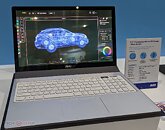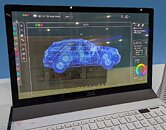TheLostSwede
News Editor
- Joined
- Nov 11, 2004
- Messages
- 18,855 (2.50/day)
- Location
- Sweden
| System Name | Overlord Mk MLI |
|---|---|
| Processor | AMD Ryzen 7 7800X3D |
| Motherboard | Gigabyte X670E Aorus Master |
| Cooling | Noctua NH-D15 SE with offsets |
| Memory | 32GB Team T-Create Expert DDR5 6000 MHz @ CL30-34-34-68 |
| Video Card(s) | Gainward GeForce RTX 4080 Phantom GS |
| Storage | 1TB Solidigm P44 Pro, 2 TB Corsair MP600 Pro, 2TB Kingston KC3000 |
| Display(s) | Acer XV272K LVbmiipruzx 4K@160Hz |
| Case | Fractal Design Torrent Compact |
| Audio Device(s) | Corsair Virtuoso SE |
| Power Supply | be quiet! Pure Power 12 M 850 W |
| Mouse | Logitech G502 Lightspeed |
| Keyboard | Corsair K70 Max |
| Software | Windows 10 Pro |
| Benchmark Scores | https://valid.x86.fr/yfsd9w |
Micro LED displays are being touted as something akin to the holy grail of display technology, but it seems like we still have some way to go before the first consumer devices are ready to launch, at least based on what we saw today at Touch Taiwan. AUO actually had multiple Micro LED displays on display at the trade show, but it appears as if there are still some technical hurdles to overcome before we'll see these products in retail. AUO was demoing a laptop prototype with a 17.3-inch Micro LED display, although the display lacked a back cover and depending on the mode used, the entire display ended up being semi transparent. This somewhat depended on the angle you looked at the display, but the idea here was to use for some kind of AR applications, or to take advantage of bright lights behind the display, courtesy of its high transmittance of up to 50 percent.
The fly in the ointment here is that the display, as well as a smaller 14.6-inch sibling—that's foldable—only supports 1280 x 720 resolution. It doesn't matter how good the technology is, if we're going to be limited to a display resolution from the early 2000's, as it simply won't sell in a modern device today. Unfortunately, this doesn't seem to be the only issue with AUO's Micro LED displays, as the display on the demo laptop also had a lot of dead pixels. We're not talking five or six here, but more like 50 or 60 and due to the low resolution of the display, they were very easy to see, as they showed up as dark dots when certain graphics were displayed. It's not all that noticeable in the pictures below, but it was very obvious when looking at the display. We were told that this is something AUO is working on solving, alongside bringing higher resolution displays to market. As such, it seems like we might still be a few years away from getting Micro LED displays in any real products. That said, the company had smaller Micro LED displays for wearables, that seemed to be much closer to hitting the production line.



View at TechPowerUp Main Site
The fly in the ointment here is that the display, as well as a smaller 14.6-inch sibling—that's foldable—only supports 1280 x 720 resolution. It doesn't matter how good the technology is, if we're going to be limited to a display resolution from the early 2000's, as it simply won't sell in a modern device today. Unfortunately, this doesn't seem to be the only issue with AUO's Micro LED displays, as the display on the demo laptop also had a lot of dead pixels. We're not talking five or six here, but more like 50 or 60 and due to the low resolution of the display, they were very easy to see, as they showed up as dark dots when certain graphics were displayed. It's not all that noticeable in the pictures below, but it was very obvious when looking at the display. We were told that this is something AUO is working on solving, alongside bringing higher resolution displays to market. As such, it seems like we might still be a few years away from getting Micro LED displays in any real products. That said, the company had smaller Micro LED displays for wearables, that seemed to be much closer to hitting the production line.



View at TechPowerUp Main Site

